Latest news
Digging Diary 2025 – Week Three
يوميات التنقيب الأثري لعام 2025 – الأسبوع الثالث
info@museitorino.it
011 44 06 903
From Monday to Saturday from 9:00 a.m. to 6:00 p.m.
Photography on Site: Capturing to Document
The weather has been changing these days in Saqqara: the light arrives earlier, and the days have turned unusually warm—almost humid. It’s strange for this time of year; the air should be cooling down. As a result, work on site has become more demanding: the sand is hotter, the air thicker.
And yet, every morning we can’t help but marvel at the spectacle of dawn. The sky reinvents itself each day—sometimes blazing with vibrant colors, sometimes veiled in softer, pastel tones. It’s a moment that fills both the eyes and the heart. We’ll admit it: as soon as we step off the minibus, we always steal a few minutes before work begins to watch the light wash over the pyramids of Dahshur.
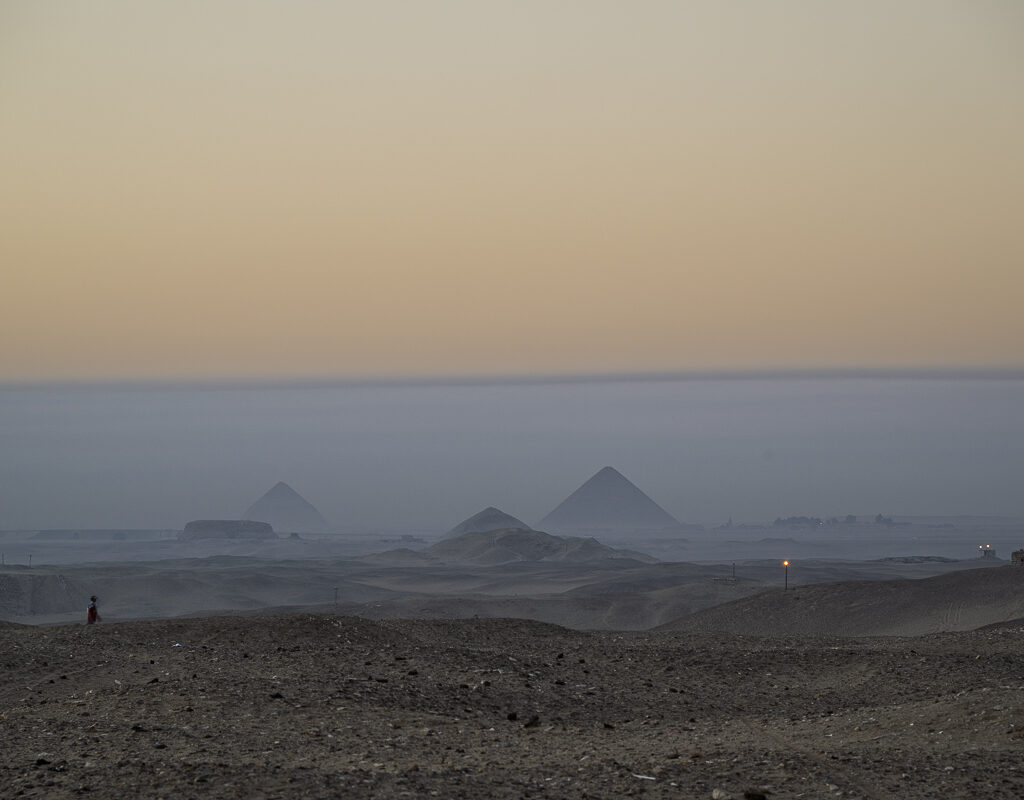
Figure 1: The pyramids of Dahshur at sunrise. Photo: Nicola Dell’Aquila
We’re now approaching the end of the mission—the fourth week will be the last—but that doesn’t mean we should rush. The work continues steadily and carefully, as always, layer by layer.
Excavation along the western perimeter of Panehsy’s tomb has paused for now: a new wall belonging to an unidentified structure has emerged, but there isn’t enough time left to explore it further. We’ll continue next year, inshallah. Our attention has now shifted east of Panehsy’s tomb, to the area of Yuyu’s chapel. Yuyu was an artisan specialized in producing gold leaf for the royal treasury. Although small in size, his chapel is decorated with remarkable finesse, depicting scenes of a funerary procession, the rebirth of the deceased, and the veneration of the goddess Hathor in the form of a cow as well as the boat of the god Sokar.
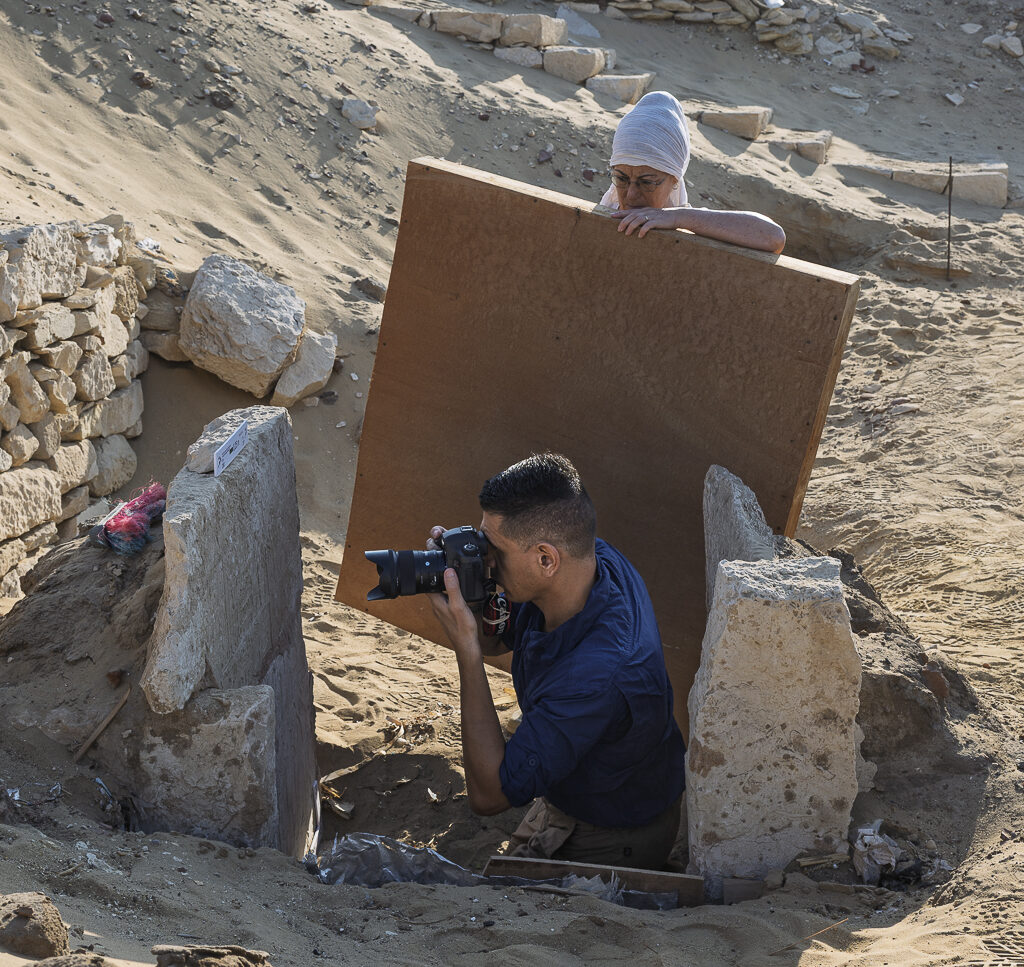
Figure 2: Corinna Rossi and Alessandro Mandelli creating the 3D model of Yuyu’s chapel. Photo: Nicola Dell’Aquila
Right next to this chapel, in a section excavated two years ago, a small wall has come to light. Could it mark the edge of another, still unknown room—an additional chamber within Yuyu’s complex? To find out, we’re carefully removing the upper layers, the same ones dating back to excavations from the 1980s, gradually reaching the Late Antique levels and aligning them with the chapel’s elevation. As always, we start from the top and follow the stratigraphy, letting the ground tell its own story.
Meanwhile, the investigation of Panehsy’s shaft has been completed—it’s now fully cleared. And that means one thing: it’s time to document the entire structure, both above and below ground. This is where photogrammetry comes into play—a technique that transforms photographs into three-dimensional models, combining the act of photography with the precision of topographic survey.
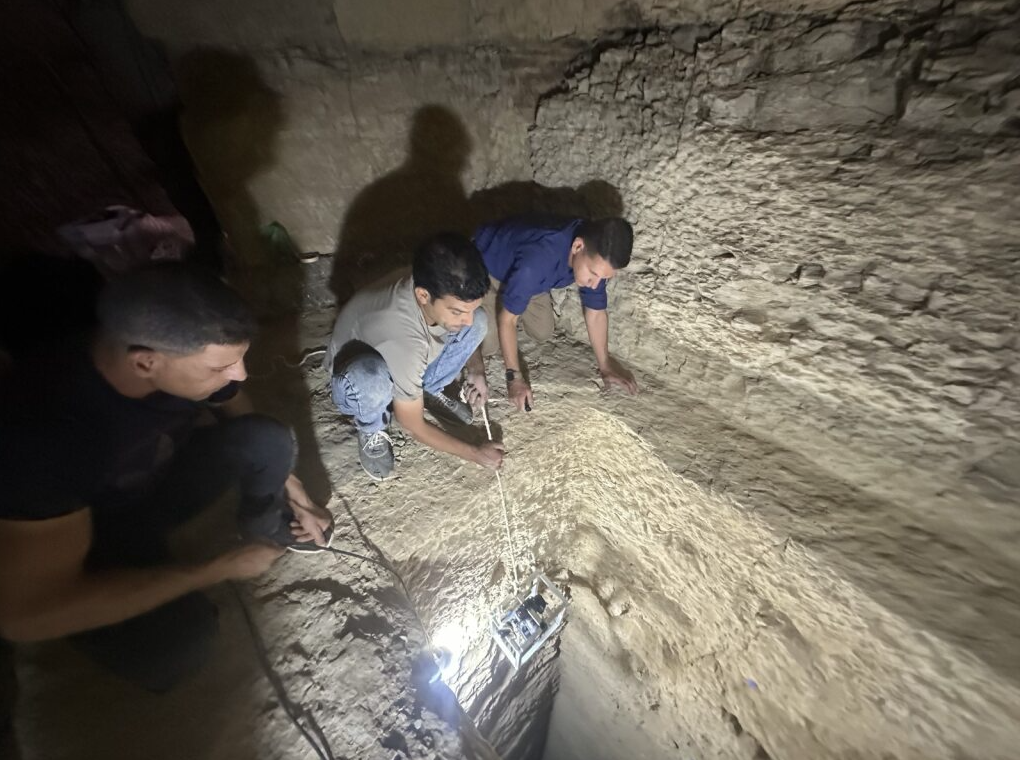
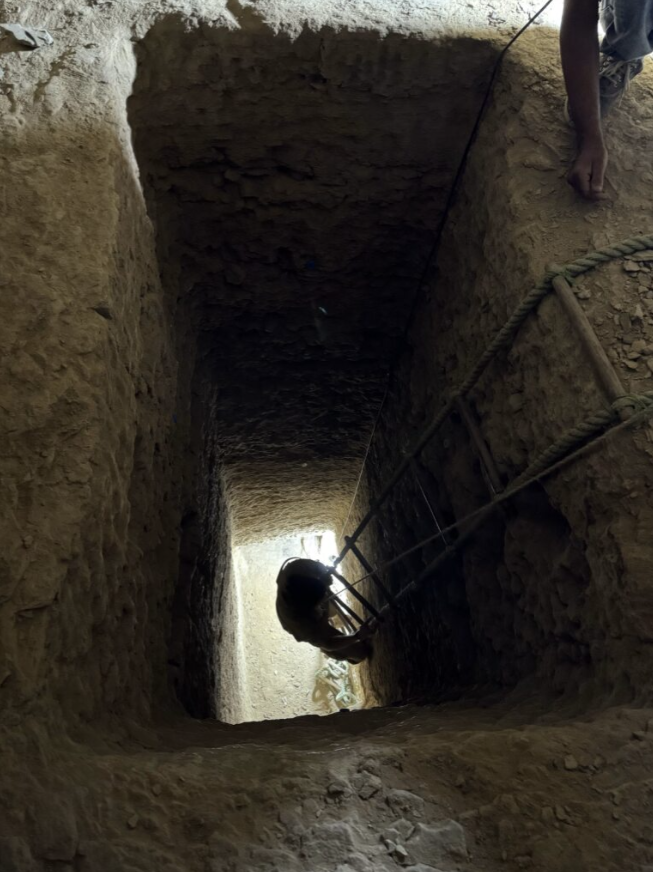
Figure 3-4: On the left, Alessandro Mandelli, Mohsen Ibrahim Saad and Walid Khaled, and on the right, Andrea Pasqui as they access the shaft of Panehsy’s tomb. Photos: Alessandro Mandelli.
Through a carefully planned sequence of shots—taken at different heights, angles, and perspectives—we create an archive of overlapping images. Specialized software processes them, calculates their spatial coordinates, and produces a 3D model accurate to the millimeter. In this way, we can “bring the tomb home,” explore it virtually, and study every detail from afar. Photogrammetry thus becomes a form of scientific memory—a way to preserve even the smallest trace of information.
Every photograph carries crucial value during an archaeological excavation. On one hand, images preserve the memory of daily life on site and of the people who took part in it; on the other, they provide indispensable scientific documentation of the finds, their state of preservation, and their context—allowing them to be studied even from a distance.
Photographing, for example, the reliefs of a tomb doesn’t just mean capturing an image—it also allows us to analyse and redraw them away from the site, though a final “face-to-face” check with the artifact is always essential. Photographic documentation is therefore an integral part of archaeological work, fundamental not only for research in the field but also for producing reports and scientific publications. The work of the field photographer is an exercise in both patience and creativity. A small studio must often be improvised: finding a stable surface, adjusting the lighting, building the right shadow, choosing a neutral background. Every detail matters—because the readability of the object depends on that photograph.
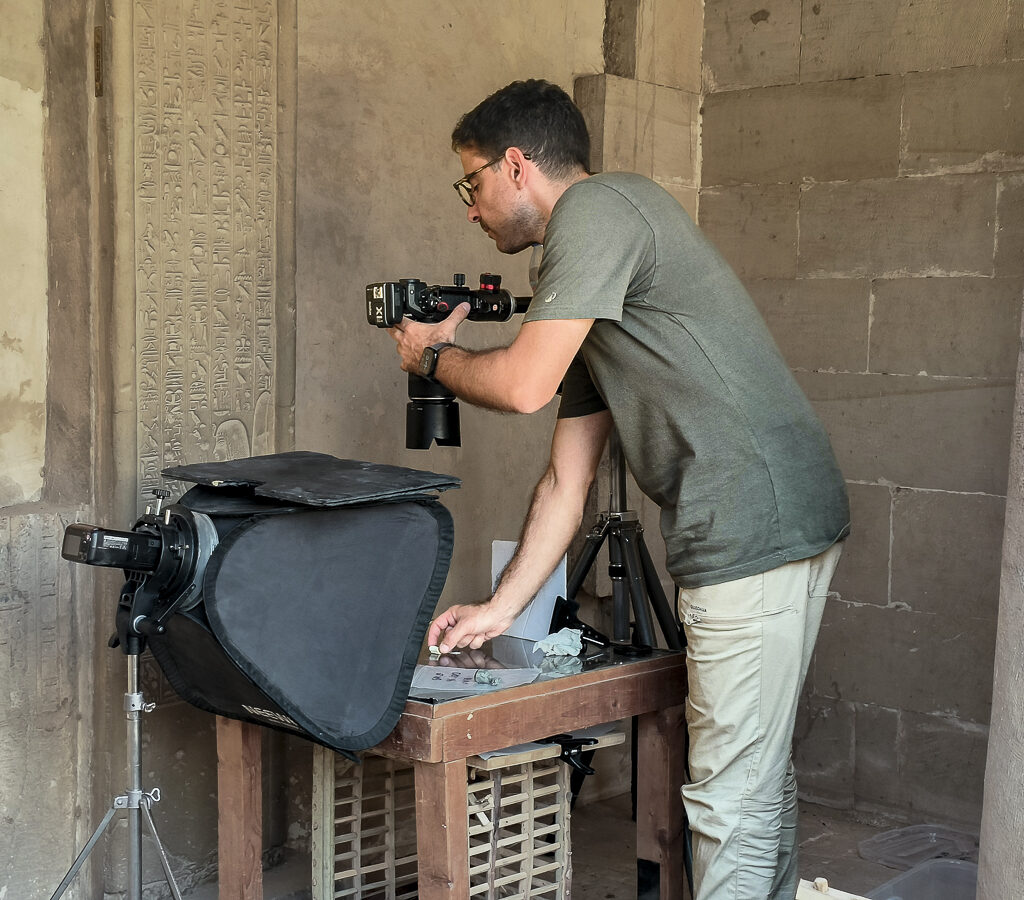
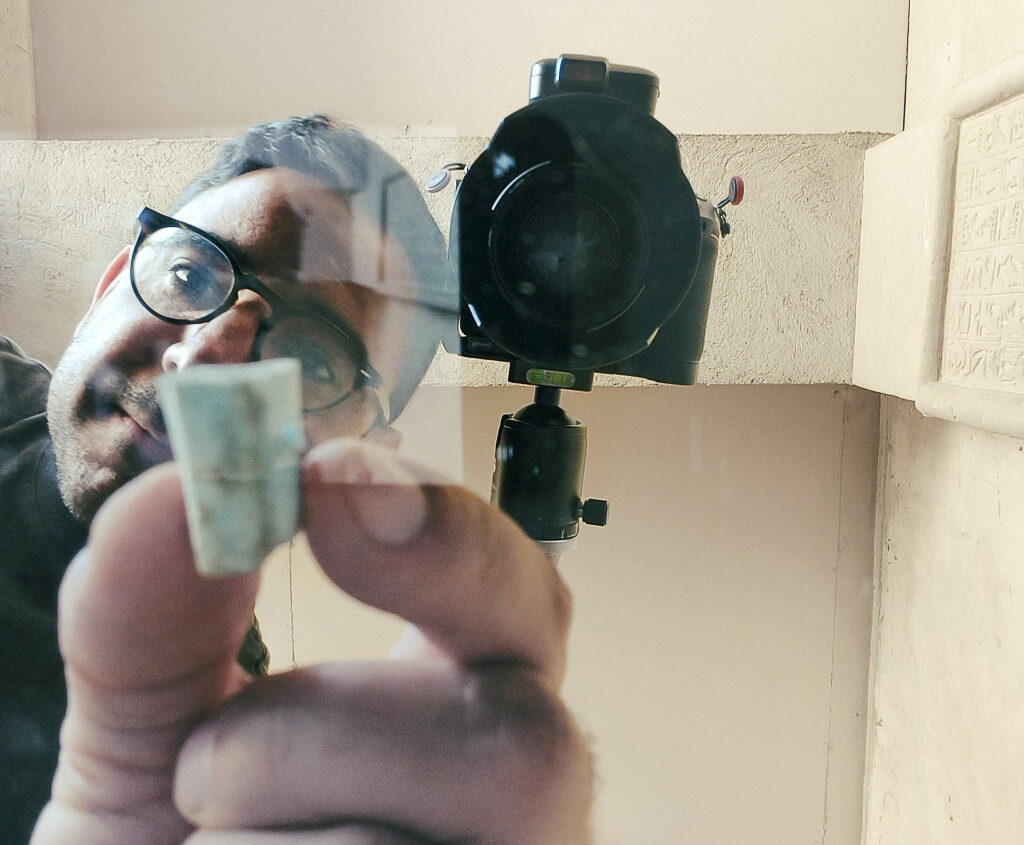
Figure 5-6: Nicola Dell’Aquila photographing finds discovered during the excavation. Photos: Divina Centore.
And the work doesn’t end there. Once back from the field, the second part of the process begins—selection, editing, color calibration, and archiving. It’s at this stage that the image becomes data, ready to interact with the drawings, measurements, and excavation records.
Because only what is documented can continue to tell its story.
See you Friday for the final chapter of the Saqqara Digging Diaries 2025.

صورة رقم 1: أهرامات دهشور عند الفجر. صورة: نيكولا ديلأكويلا
نحن الآن على وشك الانتهاء من المهمة: الأسبوع الرابع سيكون الأخير، ولكن هذا لا يقلقنا أو يدفعنا للعجلة في الحفريات، فالعمل مستمر بدقة وعناية، كما هو الحال دائماً، منسوب تلو الآخر.
الأبحاث في المحيط الغربي لمقبرة بانحسي توقفت في الوقت الحالي: فقد ظهر جدار جديد لمبنى لم يتم تحديده بعد، ولكن الوقت المتاح غير كافٍ لإجراء مزيد من التحقيقات. سنواصل العمل عليه إن شاء الله في العام المقبل. الآن تركّز اهتمامنا في الجهة الشرقية لمقبرة بانحسي، في منطقة مقصورة يويو، وهو حرفي متخصص في صناعة أوراق الذهب للأسرة الملكية. على الرغم من صغر حجم المبنى، إلا أنه مزيّن بدقة فائقة بمشاهد مختلفة، منها مشاهد من جنازة، ولادة الروح من جديد ، تبجيل الإله حتحور على شكل بقرة ومركب للإله سوكر.

صورة رقم 2: كورينا روسّي وأليساندرو مانديلي يصنعان نموذجاً ثلاثي الأبعاد لمقصورة يويو. صورة: نيكولا ديلأكويلا
بجوار هذه المقصورة الصغيرة، في القسم الذي تم إنشاؤه قبل عامين، يمكن رؤية جدار صغير. يمكن أن يكون هذا الجدار حدوداً لبناء غير معروفٍ بعد، ربما غرفة أخرى لمُجمّع يويو؟ نقوم بإزالة الطبقات السطحية للتربة بحذر لاكتشاف ذلك - وهي نفس الطبقات التي تعود إلى الحفريات التي أجريت في الثمانينيات - للوصول ببطء إلى المستويات المتأخرة من العصور القديمة لنصل الى محاذاة مستوى المقصورة. كما هو الحال دائماً، نبدأ من الأعلى ونتبع الطبقات الأرضية، ونعطي الفرصة لتلك الطبقات أن تروي عن قصتها.
في هذه الأثناء، انتهت عملية المسح في بئر بانحسي ، تم تفريغه بالكامل. هذا يعني شيئاً واحداً فقط: حان الوقت لتوثيق الهيكل بأكمله، السطحي والجوفي. وهنا يأتي دور التصوير المساحي: وهي تقنية تحول الصور إلى نماذج ثلاثية الأبعاد، وتجمع بين التصوير الفوتوغرافي ودقة المسح الطبوغرافي.


صورة رقم 3-4: على اليسار أليساندرو مانديلي ومحسن إبراهيم سعد ووليد خالد، وعلى اليمين أندريا باسكي أثناء دخولهم إلى بئر قبر بانحسي. صورة: نيكولا ديلأكويلا
من خلال سلسلة دقيقة من اللقطات التصويرية - التي يتم التقاطها من ارتفاعات ومَيَلان وزوايا مختلفة - يتم إنشاء أرشيف من الصور التي يمكننا أن نطابقها. يقوم البرنامج بمعالجتها وحساب إحداثياتها وإعادة تشكيل نموذج ثلاثي الأبعاد بدقة ميليمترية. بهذه الطريقة يمكننا ”إعادة“ المقبرة إلى شكلها الأصلي، مشاهدتها افتراضياً ودراسة كل تفاصيلها حتى عن بُعد. هكذا يصبح التصوير المساحي شكلاً من أشكال الذاكرة العلمية: طريقة للاحتفاظ بكل المعلومات حتى الصغيرة منها.
كل الصورة فوتوغرافية لها قيمتها أثناء الحفريات الأثرية: من ناحية، تحفظ ذكريات الحياة اليومية في موقع الحفريات والأشخاص الذين شاركوا فيها، ومن ناحية أخرى، تشكل وثيقة علمية قيّمة لتسجيل الاكتشافات وحالة حفظها ولمساعدة دراستها حتى عن بعد. على سبيل المثال، تصوير النقوش على قبر لا يعني فقط الحفاظ على صورتها، بل أيضاً إمكانية دراستها ورسمها بعيداً عن الموقع - مع التنويه بأن الفحص النهائي ”وجهاً لوجه مع القطعة“ يظل ضرورياً دائماً. لذا، فإن التوثيق الفوتوغرافي عمل أساسي، مفيد ليس فقط للبحث ضمن الموقع، بل أيضاً لإعداد التقارير والمنشورات العلمية.
عمل المصوّر في الميدان هو أيضاً تمرين على الصبر والإبداع. على سبيل المثال، يجب إنشاء استوديو صغير من لا شيء: العثور على سطح مستوٍ ثابت، ضبط الإضاءة، إنشاء ظل، اختيار الخلفية المناسبة. كل التفاصيل مهمة، لأن البحث ودراسة القطعة الأثرية سيعتمد على تلك الصورة.


صورة رقم 4-5: نيكولا ديلأكويلا يلتقط صوراً للقطع الأثرية التي تم اكتشافها أثناء الحفريات. صورة: ديفينا سينتوري
العمل لا ينتهي هنا بالتأكيد: بمجرد العودة إلى مقر البعثة، تبدأ المرحلة الثانية من العمل – اختيار القطع، المعالجة، معايرة الألوان، الأرشفة. في هذه المرحلة تتحول الصورة إلى بيانات، جاهزة لمساعدة الأبحاث جنباً الى جنب مع المسوحات والرسومات وملفات الحفريات.
لا نستطيع الاستمرار في سرد قصة الموقع دون الرجوع الى الوثائق والأرشيف.
نلتقي في يوم الجمعة المقبلة في الفصل الأخير من يوميات التنقيب الأثري لعام 2025.
The weather has been changing these days in Saqqara: the light arrives earlier, and the days have turned unusually warm—almost humid. It’s strange for this time of year; the air should be cooling down. As a result, work on site has become more demanding: the sand is hotter, the air thicker.
And yet, every morning we can’t help but marvel at the spectacle of dawn. The sky reinvents itself each day—sometimes blazing with vibrant colors, sometimes veiled in softer, pastel tones. It’s a moment that fills both the eyes and the heart. We’ll admit it: as soon as we step off the minibus, we always steal a few minutes before work begins to watch the light wash over the pyramids of Dahshur.

Figure 1: The pyramids of Dahshur at sunrise. Photo: Nicola Dell’Aquila
We’re now approaching the end of the mission—the fourth week will be the last—but that doesn’t mean we should rush. The work continues steadily and carefully, as always, layer by layer.
Excavation along the western perimeter of Panehsy’s tomb has paused for now: a new wall belonging to an unidentified structure has emerged, but there isn’t enough time left to explore it further. We’ll continue next year, inshallah. Our attention has now shifted east of Panehsy’s tomb, to the area of Yuyu’s chapel. Yuyu was an artisan specialized in producing gold leaf for the royal treasury. Although small in size, his chapel is decorated with remarkable finesse, depicting scenes of a funerary procession, the rebirth of the deceased, and the veneration of the goddess Hathor in the form of a cow as well as the boat of the god Sokar.

Figure 2: Corinna Rossi and Alessandro Mandelli creating the 3D model of Yuyu’s chapel. Photo: Nicola Dell’Aquila
Right next to this chapel, in a section excavated two years ago, a small wall has come to light. Could it mark the edge of another, still unknown room—an additional chamber within Yuyu’s complex? To find out, we’re carefully removing the upper layers, the same ones dating back to excavations from the 1980s, gradually reaching the Late Antique levels and aligning them with the chapel’s elevation. As always, we start from the top and follow the stratigraphy, letting the ground tell its own story.
Meanwhile, the investigation of Panehsy’s shaft has been completed—it’s now fully cleared. And that means one thing: it’s time to document the entire structure, both above and below ground. This is where photogrammetry comes into play—a technique that transforms photographs into three-dimensional models, combining the act of photography with the precision of topographic survey.


Figure 3-4: On the left, Alessandro Mandelli, Mohsen Ibrahim Saad and Walid Khaled, and on the right, Andrea Pasqui as they access the shaft of Panehsy’s tomb. Photos: Alessandro Mandelli.
Through a carefully planned sequence of shots—taken at different heights, angles, and perspectives—we create an archive of overlapping images. Specialized software processes them, calculates their spatial coordinates, and produces a 3D model accurate to the millimeter. In this way, we can “bring the tomb home,” explore it virtually, and study every detail from afar. Photogrammetry thus becomes a form of scientific memory—a way to preserve even the smallest trace of information.
Every photograph carries crucial value during an archaeological excavation. On one hand, images preserve the memory of daily life on site and of the people who took part in it; on the other, they provide indispensable scientific documentation of the finds, their state of preservation, and their context—allowing them to be studied even from a distance.
Photographing, for example, the reliefs of a tomb doesn’t just mean capturing an image—it also allows us to analyse and redraw them away from the site, though a final “face-to-face” check with the artifact is always essential. Photographic documentation is therefore an integral part of archaeological work, fundamental not only for research in the field but also for producing reports and scientific publications. The work of the field photographer is an exercise in both patience and creativity. A small studio must often be improvised: finding a stable surface, adjusting the lighting, building the right shadow, choosing a neutral background. Every detail matters—because the readability of the object depends on that photograph.


Figure 5-6: Nicola Dell’Aquila photographing finds discovered during the excavation. Photos: Divina Centore.
And the work doesn’t end there. Once back from the field, the second part of the process begins—selection, editing, color calibration, and archiving. It’s at this stage that the image becomes data, ready to interact with the drawings, measurements, and excavation records.
Because only what is documented can continue to tell its story.
See you Friday for the final chapter of the Saqqara Digging Diaries 2025.
التصوير الفوتوغرافي للحفريات: بداية من اللقطة حتى البيانات
الطقس يتغير هذه الأيام في سقارة: تشرق الشمس مبكرة، وتزداد حرارة النهار بشكل غريب، تكاد تكون رطبة. هذا أمر غريب في هذا الوقت من السنة – حيث من المفترض أن يكون الجو أكثر برودة – ذلك يزيد من صعوبة العمل في الموقع، والرمل أكثر سخونة، والهواء أكثر كثافة.
مع ذلك، لا يسعنا إلا أن نتأمل في كل صباح مشهد الفجر: السماء تجدد نفسها يوماً بعد يوم، تارةً تضيء بألوان زاهية، وتارةً أخرى تعكس السماء ظلالًا بألوان دافئة وتمازج لوني خلاب. إنها لحظات تريح العيون وتشرح القلب. بمجرد نزولنا من الحافلة الصغيرة، نسرق دائماً بضع دقائق من وقت العمل لمشاهدة أشعة الشمس وهي تضيء أهرامات دهشور.
مع ذلك، لا يسعنا إلا أن نتأمل في كل صباح مشهد الفجر: السماء تجدد نفسها يوماً بعد يوم، تارةً تضيء بألوان زاهية، وتارةً أخرى تعكس السماء ظلالًا بألوان دافئة وتمازج لوني خلاب. إنها لحظات تريح العيون وتشرح القلب. بمجرد نزولنا من الحافلة الصغيرة، نسرق دائماً بضع دقائق من وقت العمل لمشاهدة أشعة الشمس وهي تضيء أهرامات دهشور.

صورة رقم 1: أهرامات دهشور عند الفجر. صورة: نيكولا ديلأكويلا
نحن الآن على وشك الانتهاء من المهمة: الأسبوع الرابع سيكون الأخير، ولكن هذا لا يقلقنا أو يدفعنا للعجلة في الحفريات، فالعمل مستمر بدقة وعناية، كما هو الحال دائماً، منسوب تلو الآخر.
الأبحاث في المحيط الغربي لمقبرة بانحسي توقفت في الوقت الحالي: فقد ظهر جدار جديد لمبنى لم يتم تحديده بعد، ولكن الوقت المتاح غير كافٍ لإجراء مزيد من التحقيقات. سنواصل العمل عليه إن شاء الله في العام المقبل. الآن تركّز اهتمامنا في الجهة الشرقية لمقبرة بانحسي، في منطقة مقصورة يويو، وهو حرفي متخصص في صناعة أوراق الذهب للأسرة الملكية. على الرغم من صغر حجم المبنى، إلا أنه مزيّن بدقة فائقة بمشاهد مختلفة، منها مشاهد من جنازة، ولادة الروح من جديد ، تبجيل الإله حتحور على شكل بقرة ومركب للإله سوكر.

صورة رقم 2: كورينا روسّي وأليساندرو مانديلي يصنعان نموذجاً ثلاثي الأبعاد لمقصورة يويو. صورة: نيكولا ديلأكويلا
بجوار هذه المقصورة الصغيرة، في القسم الذي تم إنشاؤه قبل عامين، يمكن رؤية جدار صغير. يمكن أن يكون هذا الجدار حدوداً لبناء غير معروفٍ بعد، ربما غرفة أخرى لمُجمّع يويو؟ نقوم بإزالة الطبقات السطحية للتربة بحذر لاكتشاف ذلك - وهي نفس الطبقات التي تعود إلى الحفريات التي أجريت في الثمانينيات - للوصول ببطء إلى المستويات المتأخرة من العصور القديمة لنصل الى محاذاة مستوى المقصورة. كما هو الحال دائماً، نبدأ من الأعلى ونتبع الطبقات الأرضية، ونعطي الفرصة لتلك الطبقات أن تروي عن قصتها.
في هذه الأثناء، انتهت عملية المسح في بئر بانحسي ، تم تفريغه بالكامل. هذا يعني شيئاً واحداً فقط: حان الوقت لتوثيق الهيكل بأكمله، السطحي والجوفي. وهنا يأتي دور التصوير المساحي: وهي تقنية تحول الصور إلى نماذج ثلاثية الأبعاد، وتجمع بين التصوير الفوتوغرافي ودقة المسح الطبوغرافي.


صورة رقم 3-4: على اليسار أليساندرو مانديلي ومحسن إبراهيم سعد ووليد خالد، وعلى اليمين أندريا باسكي أثناء دخولهم إلى بئر قبر بانحسي. صورة: نيكولا ديلأكويلا
من خلال سلسلة دقيقة من اللقطات التصويرية - التي يتم التقاطها من ارتفاعات ومَيَلان وزوايا مختلفة - يتم إنشاء أرشيف من الصور التي يمكننا أن نطابقها. يقوم البرنامج بمعالجتها وحساب إحداثياتها وإعادة تشكيل نموذج ثلاثي الأبعاد بدقة ميليمترية. بهذه الطريقة يمكننا ”إعادة“ المقبرة إلى شكلها الأصلي، مشاهدتها افتراضياً ودراسة كل تفاصيلها حتى عن بُعد. هكذا يصبح التصوير المساحي شكلاً من أشكال الذاكرة العلمية: طريقة للاحتفاظ بكل المعلومات حتى الصغيرة منها.
كل الصورة فوتوغرافية لها قيمتها أثناء الحفريات الأثرية: من ناحية، تحفظ ذكريات الحياة اليومية في موقع الحفريات والأشخاص الذين شاركوا فيها، ومن ناحية أخرى، تشكل وثيقة علمية قيّمة لتسجيل الاكتشافات وحالة حفظها ولمساعدة دراستها حتى عن بعد. على سبيل المثال، تصوير النقوش على قبر لا يعني فقط الحفاظ على صورتها، بل أيضاً إمكانية دراستها ورسمها بعيداً عن الموقع - مع التنويه بأن الفحص النهائي ”وجهاً لوجه مع القطعة“ يظل ضرورياً دائماً. لذا، فإن التوثيق الفوتوغرافي عمل أساسي، مفيد ليس فقط للبحث ضمن الموقع، بل أيضاً لإعداد التقارير والمنشورات العلمية.
عمل المصوّر في الميدان هو أيضاً تمرين على الصبر والإبداع. على سبيل المثال، يجب إنشاء استوديو صغير من لا شيء: العثور على سطح مستوٍ ثابت، ضبط الإضاءة، إنشاء ظل، اختيار الخلفية المناسبة. كل التفاصيل مهمة، لأن البحث ودراسة القطعة الأثرية سيعتمد على تلك الصورة.


صورة رقم 4-5: نيكولا ديلأكويلا يلتقط صوراً للقطع الأثرية التي تم اكتشافها أثناء الحفريات. صورة: ديفينا سينتوري
العمل لا ينتهي هنا بالتأكيد: بمجرد العودة إلى مقر البعثة، تبدأ المرحلة الثانية من العمل – اختيار القطع، المعالجة، معايرة الألوان، الأرشفة. في هذه المرحلة تتحول الصورة إلى بيانات، جاهزة لمساعدة الأبحاث جنباً الى جنب مع المسوحات والرسومات وملفات الحفريات.
لا نستطيع الاستمرار في سرد قصة الموقع دون الرجوع الى الوثائق والأرشيف.
نلتقي في يوم الجمعة المقبلة في الفصل الأخير من يوميات التنقيب الأثري لعام 2025.
info@museitorino.it
011 44 06 903
From Monday to Saturday from 9:00 a.m. to 6:00 p.m.